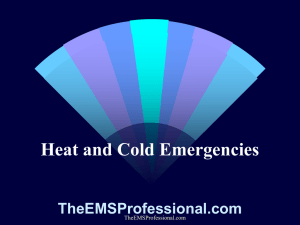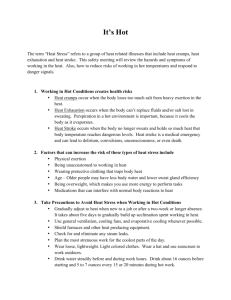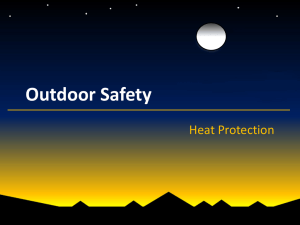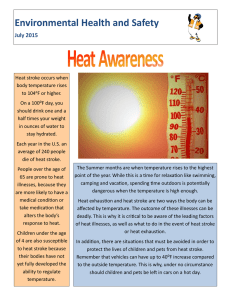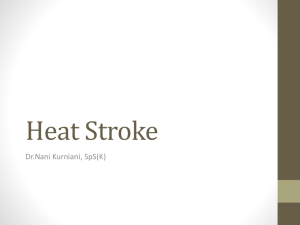Heat and Cold Exposure
advertisement
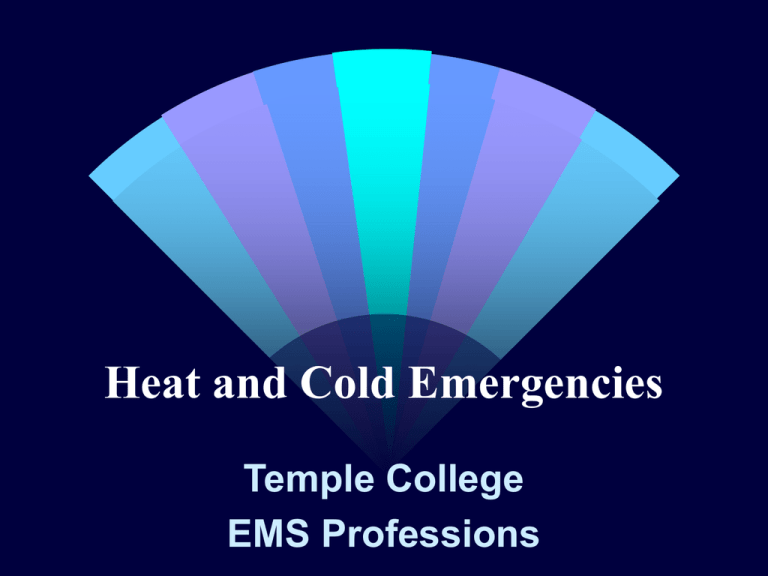
Heat and Cold Emergencies Temple College EMS Professions Heat/Cold Emergencies Metabolism runs best at 98.6oF • T0 - Metabolic rates; cell damage • T0 - Metabolic rates; cell damage Body Temperature Maintenance Balancing Heat Production, Heat Loss Heat Production Metabolism Movement of Large Muscles Shivering Heat Loss Radiation Conduction Convection Evaporation Respiration Heat Production > Heat Loss = Body Temperature Heat Loss > Heat Production = Body Temperature Heat/Cold Illness Results from: Effects of or body temperature Effects of attempting to compensate for changes in heat production, heat loss Heat Illness Heat Cramps Due to salt loss from sweating Spasms in large muscle groups Patient awake, alert Heat Cramps Treatment Stop activity Cool environment Balanced salt solution Do not give salt or water alone What would be the effect of giving only water without salt to a patient with heat cramps? Heat Exhaustion Sweating = Blood volume Vasodilation = Vascular volume Both decrease perfusion Heat Exhaustion Signs, Symptoms Dizziness Weakness Faintness Headache Nausea, vomiting Pale, cool, moist skin Why do the signs/symptoms of heat exhaustion resemble the signs/symptoms of shock? Heat Exhaustion Treatment Stop activity Cool environment Lie down, elevate legs Balanced salt solution orally, if not nauseated Transport if LOC or symptoms do not clear rapidly Heat Stroke Most serious heat-related illness Body temperature > 106oF Damage occurs to temperature regulating center in brainstem Sweating mechanism fails Heat Stroke Types Classic Exertional High Risk Groups Classic Heat Stroke Elderly Chronic medical problems • Congestive heart failure • Obesity • Alcoholism High Risk Groups Exertional Heat Stroke Small children in closed vehicles Athletes, military recruits, construction workers, on hot humid days Heat Stroke Signs/Symptoms Body temperature Hot, dry, flushed skin Absence of sweating Altered mental status • Confusion, irritability • LOC • Coma Seizures LOC + Hot Environment equals Heat Stroke until proven otherwise Heat Stroke Treatment High concentration O2 Assist ventilations as needed Rapidly cool to 102oF Transport Cold Emergencies Frostbite Localized cold injury Subfreezing temperatures Vasoconstriction occurs • Blood flow to distal circulation (nose, ears, fingers, toes) • Water in tissues freezes; tissue damage occurs Frostbite Signs/Symptoms Mild (frost nip): Red, burning areas Superficial: White, waxy, doughy-feeling Deep: Dead white, hard, no sensation Frostbite Treatment Remove from cold Dry areas gently, wrap in sterile dressing Transport If transport prolonged, rewarm rapidly in 100-105oF water Frostbite Treatment Do NOT rub frostbite Do NOT allow refreezing Do NOT allow patient to smoke Hypothermia Generalized cooling of body Can occur at temperatures above freezing Hypothermia Risk Groups Homeless Alcoholics Elderly living in poorly heated homes Outdoor sports participants LOC + Cool Environment equals Hypothermia until proven otherwise Hypothermia Treatment Support airway, breathing 100% O2--warmed, if possible Prevent further heat loss Do not aggressively rewarm Treatment for Hypothermia Avoid rough handling Transport Hypothermia can cause apparent absence of vital signs Always resuscitate You’re not dead until you’re warm and dead!
